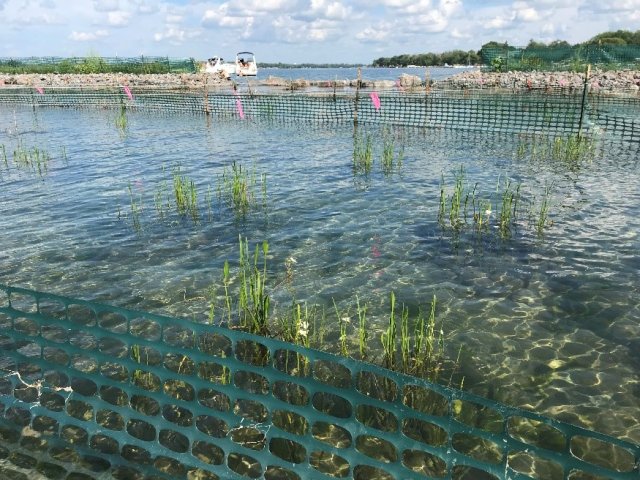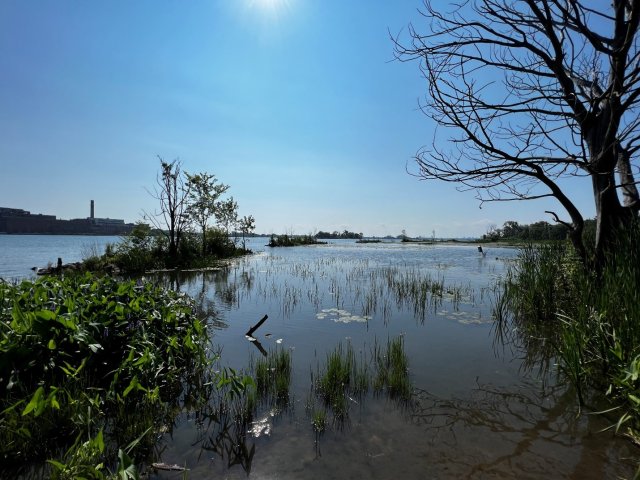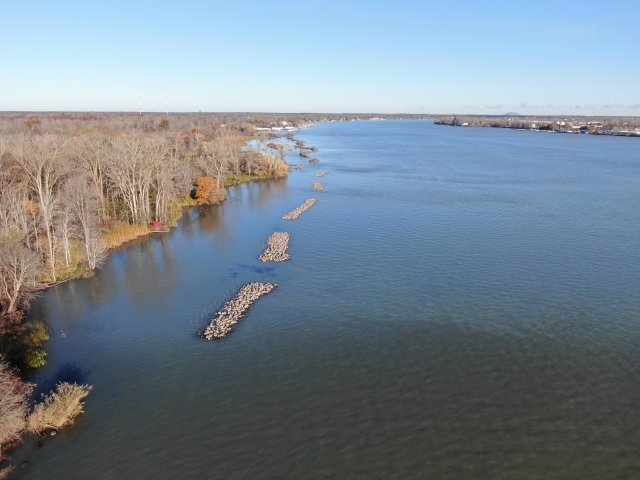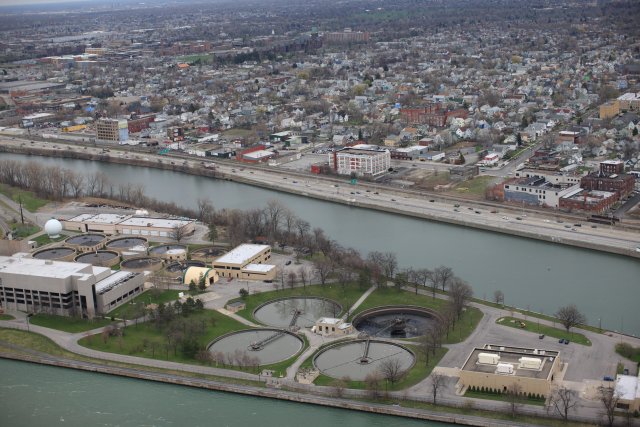Niagara River AOC Remediation and Restoration Work
Highlighted Habitat Restoration and Sediment Remediation Work
The projects highlighted below represent both completed and existing projects within the AOC. These projects will advance progress and lead to BUI removals.
- Buckhorn Island/ Grass Island Restoration Project
- Emerald Shiner Fish Passage Restoration Project
- Spicer Creek Wildlife Management Area Restoration Project
- East River Marsh Extension Restoration Project
- Burnt Ship Creek Restoration Project
- Black Rock Canal Cleanup
Restoration Project Highlight: Buckhorn Island/ Grass Island

Grass Island is a 13.5-acre lobster shaped partially submerged marshland off Buckhorn Island State Park. The island provides spawning and nursery habitat for fish and nesting habitat for waterfowl. Furthermore, it is a key stopover site for purple martins during migration as they spend one- or two-weeks during May and August before going to South America.
With the goal of maintaining and expanding wetland and aquatic habitat, the Great Lakes Restoration Initiative (GLRI) funded $5.5 million in habitat restoration projects at several locations. The restoration package included adding new rock reefs, root wads and aquatic vegetation to Grass Island. The installation of rock reefs protects vegetation from waves and ice scour. The construction of the rock reefs has helped lure birds back as seen with the return of a robust purple martin populations to the area.
The Grass Island Restoration project one of four habitat restoration sites that is considered to have a significant impact on the removal of the following BUIs:
- Loss of Fish and Wildlife Habitat
- Degradation of Fish and Wildlife Populations
Restoration Project Highlight: Emerald Shiner Fish Passage
Emerald shiner is a small prey fish that is critical to the Niagara River and Lake Erie food web as larger fish and wildlife depend on them. As a result of hardened shorelines along the Niagara River, high water velocities had limited the ability of emerald shiner to migrate to Lake Erie therefore posing a threat to their population.

In May of 2022, the Emerald Shiner Fish Passage restoration project was completed along the Niagara River adjacent to Broderick Park in the City of Buffalo. Funded through the Great Lakes Restoration Initiative (GLRI), this project repaired approximately 78 feet of the existing seawall and installed baffles designed to reduce the water velocity below what is necessary to support emerald shiner migration. Monitoring of the stability and performance of the baffles, as well as fish passage, was determined a success. Design of phase II of the project, which includes the extension of the baffles along the remaining 700 feet of the seawall, are underway. Once the project is complete, Emerald Shiner will have migratory access to Lake Erie.
Improving passage for the Emerald Shiner has helped meet Fish Community Objectives and contributes to the removal of the following BUIs:
Degradation of Fish & Wildlife Populations
Restoration Project Highlight: Spicer Creek Wildlife Management Area
Spicer Creek Wildlife Management Area is a 34-acre area managed by The New York State Department of Environmental Conservation (DEC). Located in Grand Island along East River Road, the area includes approximately 26 acres of wetland, 8 acres of brushland and woodland, and a portion of the Niagara Riverbed. Historically, the Niagara River had extensive coastal wetlands however most of the wetlands have been degraded by industrialization, development and pollution.
DEC and U.S. EPA in collaboration with state and federal partners, restored wetland habitat through the promotion of shallow-water vegetation growth near the shoreline with the placement of low-profile berms. In total, this restoration project restored 16 acres of habitat along the Grand Island Shoreline and approximately 3,760 linear feet of shoreline. Construction was completed in 2022.
This $2.2 million habitat project is funded by the Great Lakes Restoration Initiative (GLRI).
The restoration project of Spice Creek Wildlife Management Area is considered to have a significant impact on the removal of the following BUIs:
- Loss of Fish and Wildlife Habitat
- Degradation of Fish and Wildlife Populations
Restoration Project Highlight: East River Marsh Extension
The New York State Parks, Recreation and Historic Preservation (NYSPRHP) received Great Lakes Restoration Initiative (GLRI) funding in 2003 to expand on improvements to the East River Marsh. The East River Marsh Project area faced several challenges including shoreline erosion, loss of habitat, lack of wetlands along the river’s edge, and few places for fish and wildlife to breed. This project was completed the summer of 2019 and included the installation of five rock reefs that will protect the shoreline, stabilize riverbanks, and reduce erosion. This will encourage submerged and emergent vegetation growth and expand river wetland habitats.
Additionally, the project included two areas of shoreline dredging creating potholes, channels, and open water. The project also included the installation of cable logs, rock sills, and crib boxes, extensive planting of native aquatic vegetation, shrubs and trees. The restored riparian area will provide habitat for a variety of fish, birds, and other wildlife.
Protection and enhancement of shallow water coastal wetlands has been identified by the Remedial Advisory Committee for the Niagara River AOC as a priority action required for the removal of the following BUIs:
- Loss of Fish and Wildlife Habitat
- Degradation of Fish and Wildlife Populations

An interagency subcommittee has prioritized this and five related projects along the Grand Island shoreline due to the perceived opportunities to restore this threatened and valued habitat type. The East River Marsh Extension Restoration Project enhanced over 9 acres of habitat along more than 1,000 feet of shoreline.
Restoration Project Highlight: Burnt Ship Creek
The Burnt Ship Creek was a former stream channel that had been encroached by hybrid cattail. This encroachment restricted aquatic and wildlife passage and reduced biodiversity and productivity.
The restoration project involved dredging out extensive cattail growth along Burnt Ship Creek and planting a variety of native submerged and emergent vegetation. This will restore the stream channel, increase open water, and improve water movement through the marsh. These enhancements provide access and use of the marsh by fish and wildlife, allowing fish passage into the wetland and habitat enhancement for fish, waterfowl and other wildlife, while increasing native plant diversity and resilience.
Construction was completed in 2020. The project included about 900 feet of dredging for fish passage, cover habitat enhancements and open water habitat feature enhancements. The project also reconnected the Niagara River to an extensive wetland at Buckhorn Island State Park, providing access for fish and wildlife again.
The Burnt Ship Creek Restoration project is considered to have a significant impact on the removal of the following BUIs:
- Degradation of Fish and Wildlife Populations
- Loss of Fish and Wildlife Habitat
Project Highlight: Black Rock Canal Cleanup
The Black Rock Canal is a Federal harbor in the Niagara River Watershed in Buffalo, NY and falls within the Niagara River AOC. This project involved the planning, design and removal of about 180,000 cubic yards of contaminated sediments from the navigation channel in order to support the removal of several BUIs. The dredging removed legacy sediment, material which contained industrial contaminants from years past. The sediment was dredged in 2014 and 2015.
This project was considered a strategic navigation dredging project under the Great Lakes Restoration Initiative, because the Canal was not planned to be dredged by the U.S. Army Corps of Engineers, and it was a necessary project for BUI removal.
Completion of the project advanced efforts towards the removal of the following BUIs:
- Degradation of Benthos
- Restrictions on Dredging Activities
- Bird or Animal Deformities or Reproduction Problems
The Black Rock Canal Cleanup Project was a collaborative effort among the following project partners:
- New York State Department of Environmental Conservation
- U.S. Army Corps of Engineers
Partners
- National Oceanic and Atmospheric Administration
- U.S. Army Corps of Engineers – Buffalo District
- U.S. Fish and Wildlife Service
- U.S. Geological Survey
- Buffalo Niagara Waterkeeper
- Canadian Niagara River RAP
- Great Lakes Research Consortium
- New York State Department of Environmental Conservation
- New York State Office of Parks, Recreation and Historic Preservation
- New York Sea Grant
- Niagara River Greenway Commission





